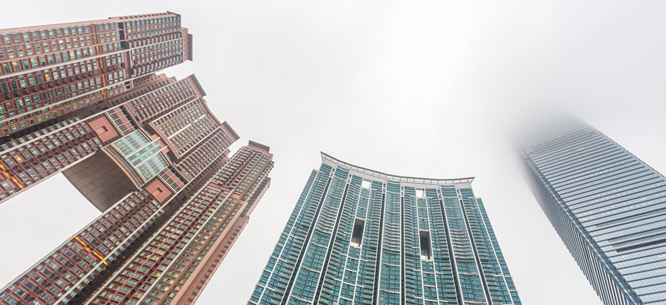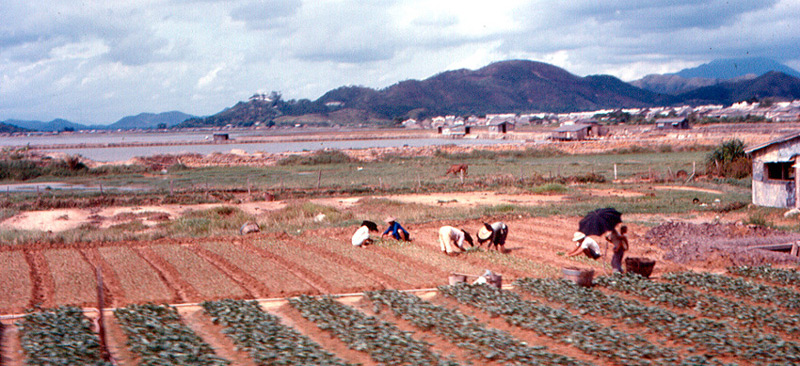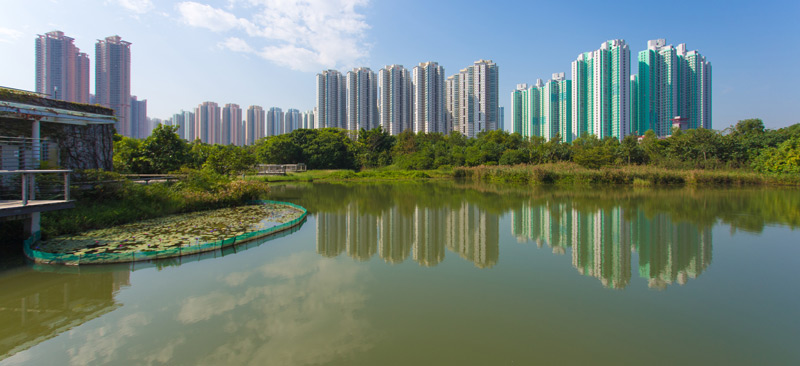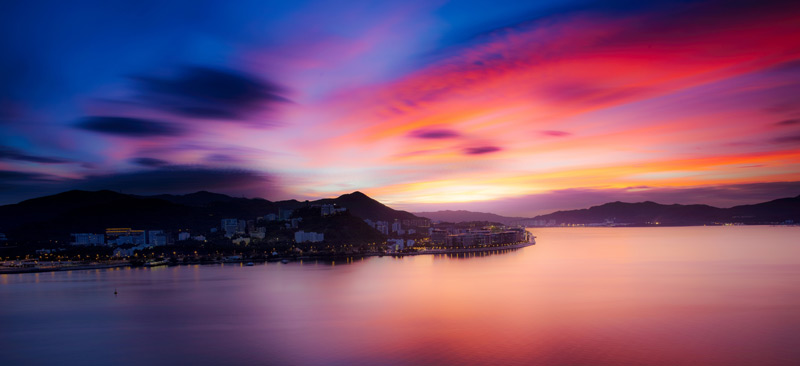Hong Kong’s Oligarchy
Hong Kong’s Oligarchy
In its call for electoral democracy, the Umbrella movement sought to challenge China’s tight grip on Hong Kong politics. But Hong Kong’s protesters have yet to confront the deeper interests tying their future to that of the mainland.

Three months after the police shut down the pro-democracy movement that made headlines last fall, a new wave of protests crested in parts of Hong Kong. The protests were smaller in scale, much less representative of the Umbrella Movement’s many voices, and angrier, erupting in shopping streets and malls near the Chinese border in February and March. Their grievances weren’t with the mechanics of voting, but with so-called “parallel traders” from the mainland who have been sweeping tax-free products such as baby formula off the shelves in Hong Kong and reselling them across the border for profit. Protesters accused the traders of driving up retail prices and rents, while neighborhoods transform themselves to serve mainland tourists rather than local communities. They blamed the government for granting permits that allow vast numbers of visitors to enter as well as unlimited travel for residents from Shenzhen, a neighboring city. Their discontent, despite its economic slant, turned aggressive and xenophobic.
Like these recent protests, the mass mobilization and occupations last fall had roots in economic grievances as well as in an identity crisis. The push for democratization in Hong Kong challenges not only Beijing’s tight grip on local politics but also deep structures of collusion between the territory’s economic and political elites. The government’s estimated budget surplus of $8.25 billion, announced last month, offered little solace to everyday Hong Kongers, for whom the fiscal glut isn’t expected to relieve any economic distress.
Perhaps a better reflection of the state of affairs in Hong Kong was the verdict in late December, coming just a week after the police’s anticlimactic clearance of the months-long protests, that ended the highest-profile corruption trial in the territory’s history. All in their sixties, the convicted include former chief secretary Rafael Hui and Thomas Kwok, former joint-chairman of Sun Hung Kai Properties, one of Hong Kong’s largest real-estate firms. Yet the graft scandal only provided a glimpse into the oligopolies, aligned with state interests, that preside over Hong Kong soil. Their enormous power accounts for much of the territory’s wealth gap and its increasing unaffordability for those whose labor keeps the economy ticking.
The patriarchs of the real-estate industry are household names in Hong Kong, by virtue of being among Asia’s most prominent billionaires and of their control over the most valuable natural resource in the tiny region: land. Dominated by just a few families, the leading developers control not only property—including residential and retail spaces, industrial and office buildings, and hotels—but also key services like electricity, gas, public transportation, and telecommunications. For example, Sun Hung Kai Properties manages a major mobile phone company and a public transport operator that runs in Hong Kong as well as in some mainland Chinese cities. Cheung Kong Holdings, led by Li Ka-shing, Asia’s richest man, draws profits from one of both the supermarket and the electricity duopolies, some of the world’s busiest ports, and majority ownership of the world’s largest health and beauty retailer, among other businesses. His younger son, Richard Li, chairs a giant telecommunications company with IT, real-estate, and venture-capital arms and other investments reaching deep into markets across Asia. Li Ka-shing, in a Forbes profile, proudly explains that his empire is named after the Yangtze River, “whose power comes from a confluence of countless smaller streams.”
Facing little competition, and with a stranglehold on pricing, these developers have tremendous influence over the everyday necessities consumed by ordinary Hong Kongers. Author Alice Poon, who once served as personal assistant to Thomas Kwok’s father, the late founder of SHKP, has gone so far as to argue that these family-owned conglomerates have a kind of power just “a shade different from that in the feudal ages.” The government’s monopoly on land supplies has not led to more communal forms of ownership, but to a public-private partnership that treats living space as a commodity rather than a human right.
While December’s verdict exposed a high degree of property-related corruption, it hardly challenged the dominance of the cross-sector behemoths. And even amid the scandal of the trial, there was little talk of pushing the government to enforce stronger competition laws that could begin to dismantle the entrenched power structures at hand.
Today’s sky-high property prices and developer-friendly land policies are legacies of the colonial era, when the British authorities depended heavily on land sales for revenue—much like the current government. As Poon chronicles in her authoritative book Land and the Ruling Class in Hong Kong, Chinese developers have gradually taken the place of their land-rich British predecessors in the last few decades. The Cultural Revolution in the mainland and the 1967 anti-colonial riots in Hong Kong forced British companies to scale back on assets and investments. Local entrepreneurs took advantage of the political turmoil and market crashes—including one prompted by a bank run in 1965 and another by the 1967 riots—to hoard cheap developable sites.
Throughout the 1960s and ‘70s, as Hong Kong became a manufacturing hub powered by immigrants from the mainland (who were fleeing the Cultural Revolution and seeking economic opportunities), the new real-estate moguls rose. They survived the dips in prices that drowned out smaller competitors and made their fortunes as demand for housing and factory spaces surged. All the while, the government fed on land revenue brought in by its leasehold system and high property prices—a hidden tax. In the ensuing decades, Hong Kong’s population continued its sharp rise, and developers used their wealth to snap up other sectors. As Hong Kong transitioned into a bustling port and later an established service economy and active stock market, they consolidated their empires.

The property giants’ spatial dominance forms the economic backdrop to the pro-democracy protests that rocked Hong Kong last fall. Taking over the busiest parts of the city, which are also among the most expensive shopping streets in the world, protesters demanded to choose their next leader by unimpaired popular vote in 2017. Moderates dismissed their vision of electoral reform as too radical or idealistic, yet judging by the protesters’ focus on electoral democracy—rather than on transforming a political economy controlled by oligarchs—their demands were if anything not far-reaching enough.
For such a wealthy territory, consistently heralded for its “economic freedom,” Hong Kong generates living conditions that have been described as “logic defying.” Developers keep downsizing the apartments they put on the market, the New York Times reported; a portion of the territory’s population lives in metal cages, others in tenements nicknamed “coffin homes”; “microflats” are priced exorbitantly. Liber Research Community, a grassroots think tank in Hong Kong, calculated that the average living space for each person in 2014 was 161 square feet. On the other hand, reports said home prices have more than doubled since 2009, driven by demand from mainland buyers that amounted to as much as 40 percent of new home sales at one point.
These dismal conditions have prompted protests of their own, specifically targeting the collusion between Hong Kong’s real-estate empires and government, and eschewing the xenophobic rhetoric on display at the protests against “parallel traders.” Last May and June, not long before the so-called dress rehearsal for Occupy Central took place in July, Hong Kong saw a series of demonstrations, much smaller in scale, against a controversial development plan. Government officials have promoted the plan, which was first conceived in 1998 but has been gaining steam only in the last five years, as a “multi-pronged approach” to create real-estate supply; its professed aim is to address, foremost, the housing needs of a space-starved population. The proposal, however, consists mostly of new luxury properties and retail spaces catering to mainland tourists—along with subsidized housing units “for ordinary people,” the government insists—that are likely to displace at least 6,000 villagers and farmers in the northeastern parts of Hong Kong, bordering the Chinese mainland.
The bill to approve preliminary funding for the billion-dollar project bulldozed its way through a disorderly Legislative Council surrounded by protesters in late June of last year. Ng Leung-sing, chairman of the Finance Committee that rushed the bill through, is a director of the mobile phone company that is a subsidiary of Sun Hung Kai Properties. He is also the chairman of Bank of China’s Trustees. (The motions to investigate any potential conflict of interests were rejected.) But the clamor around the New Territories project was soon overpowered by calls for electoral democracy in the mass movement that followed.
Meanwhile, Hong Kong’s real-estate magnates are keeping their eyes on swaths of land far away from the power hubs that protesters occupied. The media generally referred to Hong Kong as the “city” in their coverage of the mass protests, but it is really an archipelago of islands, islets, and rocks forming a rough coastline at a southeastern corner of China; developed sites currently make up less than a quarter of it. The “New Territories,” stretching south from the Chinese border and making up over 85 percent of Hong Kong, are a mountainous and low-lying patchwork of natural environment, villages and farmlands, campuses, industrial pockets (both functioning and deserted), high-density “suburbs,” and new town developments. This area—the last carved out by the United Kingdom in 1898, following the cession of Hong Kong Island and the Kowloon Peninsula—had long served as a kind of frontier between the urban centers of Hong Kong and the manufacturing hub of Shenzhen, China.
For property developers, the agricultural backcountry has been a gold mine. Sun Hung Kai Properties and Henderson Land, another mammoth real-estate firm (which is also a shareholder in Hong Kong’s town gas monopoly and ferry services), aggressively bought these farmlands in the New Territories at negligible costs back in the 1970s and ’80s, building up vast land banks for future development. In recent years, their fortunes have swelled from the new towns’ retail, property, and entertainment complexes, which are popular with mainland shoppers and investors. But the government’s specific plan to develop the northeast New Territories, largely owned by Henderson Land, has a broader strategic vision: to integrate Hong Kong with the mainland, first by molding a cityscape and transport network at the borderland.
The central planners in China have put their own twist on this vision for the former colony: Hong Kong is to become an integral part of the Pearl River Delta, China’s emerging constellation of megacities near the southern coast. The Pearl River Delta encompasses nine cities in the region that will “push forward its intimate cooperation, integration, and common development with Hong Kong and Macau”—the former Portuguese colony and China’s second special administrative region alongside Hong Kong—to “forge jointly the most dynamic and internationally competitive city cluster of the Asia-Pacific region.” The Bauhinia Foundation Research Centre, a think tank closely associated with the government, uncovered another plan back in 2007 to merge Hong Kong and Shenzhen into one metropolis that aspires to surpass other global cities and finance hubs such as London and Paris by 2020. A collaboration between the two city governments, known as the “Shenzhen-Hong Kong Innovation Circle,” was to mold the pair into a joint high-tech hub, until the withdrawal of an American company’s local subsidiary put a damper on the project.
“China’s long-term plan for Hong Kong is . . . about reimagining the geography of the whole region,” says historian Angelina Chin. “Instead of remembering Hong Kong as a unit, it is being replaced by the Pearl River Delta region. . . . [T]he point is to dissolve the boundaries of Hong Kong”—boundaries shaped largely by its colonial past.

A number of Hong Kongers—even those who condemn the “anti-mainland” animosity taken up by some protesters in recent years—have responded to this prospect with a kind of moral panic complicated by economic woes and strained resources. Middle-class critics in the mainstream press mourn the loss of Hong Kong’s distinctive culture as it turns into “just another Chinese city.” Others mourn the erosion of the territory’s cherished values, such as freedom of the press, or even the ability and willingness to remember, ponder, and speak about China’s grim modern history—something not so easily afforded to the rest of the country.
But the integration project has also spurred a grassroots response by Hong Kongers who have more to lose than their sense of cultural superiority: their land. “Integration itself is not the problem,” said Cho Kai-kai, a member of an organic farm that was created in honor of a village soon to be demolished. “Hong Kong’s fate has always been closely entwined with the mainland’s economic and political circumstances at different periods. Our critique now of integration is that it’s top down and skewed towards developers and financiers.” Founded in 2010, Mapopo Community Farm also acts as a grassroots organization advocating for sustainable development. Its members view agriculture in Hong Kong as neither marginal nor obsolete, but as a sector vital to the territory’s overall development. The plan to uproot the New Territories’ remaining pockets of agriculture will only deepen Hong Kong’s already heavy reliance in the Pearl River Delta for food, energy, and water, as scholars like Angelina Chin have also noted. “Agriculture now only takes up 3 percent of Hong Kong soil; we can’t afford to lose any more of it,” said Cho.
The integration project’s ambition to rapidly urbanize 85 percent of the Pearl River Delta region relies on extensively developing transport links, which have caused their own share of controversy. In 2009 and 2010, outrage erupted at the construction of a high-speed railway between Hong Kong and Guangzhou, a manufacturing center in the Delta that also shares Hong Kong’s Cantonese heritage. This particular branch will extend from the national rail linking up other major Chinese cities all the way to Beijing, demolishing another farming village in the New Territories en route. Revealing as it was of Hong Kong’s developmental logic, the approval of the new rail link was a galvanizing moment for villagers and a young generation of activists. The project incited a spate of protests, including sit-ins and a “prostrating walk” inspired by Tibetan pilgrims, but construction has made headway despite some delays; the rail line is projected to begin operating in 2017.
As it forges ahead with the integration plan, the Hong Kong government continues to insist that the northeast New Territories rezoning and development project is primarily aimed at solving the region’s housing crisis. But researchers argue that in practice, the government’s reliance on the private sector to increase housing supply is unlikely to bring about more affordable prices. Instead, the plan will continue to profit the real-estate oligarchy above all, while displacing villagers from their homes and arable land. There is also concern that the construction will swallow up a statutory “green belt” that overlaps with the affected villages—violating the basic premise of a green belt, which is to prevent overdevelopment.
Chan Kim-ching, a researcher at Liber Research Community, questions the government’s motive for targeting agricultural areas for development—specifically those acquired decades ago by the property giants. If the real goal is to create affordable housing, he argues, less disruptive options are available.
“The government keeps framing the debate around the question of land supply, but they haven’t been transparent about their land reserve figures,” said Chan, who suggested that the government consider other options such as brownfield sites or vacant land. The official figure for vacant land alone is 4,000 hectares, more than half of which are already zoned for residential use. Studies conducted by the Liber Research Community have challenged a central tenet of government rhetoric: that land in Hong Kong is always in short supply, and that the only solution is continuous urbanization led by private developers. “Scarcity is relative,” Chan continued, “but the government talks about it as absolute.”

In post-Occupy Hong Kong, people are disenchanted, and the voices of dissent divided. The wave of protests against “parallel traders,” led by so-called localists, is dangerously channeling economic grievances into ethnic ones; meanwhile emerging discourses about independence have led to a split within the Federation of Students, one of the organizations leading the movement last fall. The fight for environmental justice, more equitable distribution of land, and, for some, territorial integrity goes on, yet it has not captured public attention as much as the loftier pro-democracy movement did. But the latest controversy—over the multi-billion-dollar construction of a third runway for the once top-ranking Hong Kong International Airport—has fired up criticisms over financing concerns, pollution, and airspace miscalculations, serving as a rallying point across various groups.
Despite flashes of outrage, none of these developments look poised to bring about a new mass protest movement—yet. Hong Kong is now holding its breath for next month’s unveiling of another election reform proposal, while the government moves along with what it calls a five-step process of constitutional development. A cosmetic promise of universal suffrage, shackled (like last fall’s proposal) by Beijing’s vetting, the proposal could still be blocked by pro-democracy lawmakers unless it passes with a two-thirds majority.
Meanwhile, Hong Kong’s majority has kept quiet on the long-suspected collusion between government and the landed oligarchs. Apparently, for some, luggage-hauling tourists have made for an easier target. Still, supporters of meaningful reform may no longer be able to set the issue aside. As long as the territory’s elites keep making Hong Kong less and less livable for working people, their discontents will grow.
Elaine Yu is a journalist from Hong Kong. She has reported on the pro-democracy movement for the Nation, the New Yorker, VICE News, and other publications.





